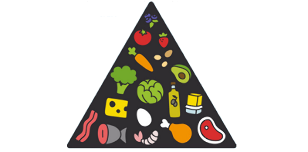“The keto diet burns fat, but still maintains an excellent caloric intake, allowing you to preserve muscle mass and a good metabolic rate. It's not for nothing that more and more people are choosing the keto diet. These are not just the principles of nutrition, this is a biohacking tool "- these words can be read today in the social networks of the adherents of the keto diet. Is it really? Let's look at this question objectively andwe evaluate the pros and cons
The essence of the ketogenic diet is to eliminate carbohydrates as much as possible (and it's not just about baked goods, pasta, sugar and its substitutes, but also honey, fruit, root vegetables, cereals and rice in any form). A 5% share of carbohydrates is allowed in the diet due to berries, herbs and some vegetables.
For comparison: in the standard food pyramid, regulated by the World Health Organization as the basis of a balanced diet, the proportion of carbohydrates can be up to 60%.
As you know, it's not safe to eat a protein diet, but where do you get your energy from? The answer is in the fats. You shouldn't be afraid of it; the horrors of cholesterol, which frightened people throughout the 20th century, in the 21st century are considered the intrigues of the pharmaceutical companies concerned. It is important to make a correction: we are talking about the right fats, rich in polyunsaturated fatty acids, and not about juicy kebabs, margarine and trans fats, which are harmful to health.
WHAT IS KETOSIS? HOW DOES THE KETO DIET WORK?
Dietary principle
The body uses carbohydrates as the main "fuel" for the brain. With a sharp reduction in dietary carbohydrates below 20 grams per day, the amount of glucose is critically reduced and there is not enough energy for normal functioning and fat oxidation. To feed the brain, the body begins the process of obtaining alternative energy: ketosis. This is a condition that develops due to the carbohydrate starvation of the cells, when the body begins to break down fat for energy to form large numbers of ketone bodies. In the normal state, the concentration of ketone bodies in the blood is very low, as they are replaced by glucose and the body does not need additional energy. During ketosis, the concentration of ketone bodies increases sharply.
Ketosis can also be achieved by fasting for several days, but this is extremely harmful. The keto diet is an alternative to complete fasting that can cause less damage to the body. Along with nutrition, we continue to receive all the necessary substances and do not experience hunger, excluding only carbohydrates and forcing the body to start the process of breaking down fat.
The keto diet has a pretty solid scientific basis; showed excellent results in children and adults with epilepsy - up to the disappearance of the convulsive syndrome against the background of the withdrawal of anticonvulsants. It is effective for people with certain autoimmune diseases and Alzheimer's disease, as well as for people with cancer. The fact is that cancer cells "feed" on glucose, and according to studies, switching to a low-carbohydrate but high-fat diet leads to regression of the tumor process.
Observations of patients who adhere to this nutritional model have shown that, strangely enough, a person begins to feel a surge of energy, brain activity increases and mood improves. The secret lies in the biochemical processes: the body switches to new sources of energy: ketones, formed during the breakdown of fat.
The first popularizers of the keto diet were biohackers who wanted to live healthy and active into old age.
Hollywood stars joined them, and then the keto diet craze took over the world. Removing excess fat by consuming fat can simply be a challenge.
However, only an experienced dietician should prescribe the keto diet. Not a dietary advisor, not an Insta food blogger, not a nutritionist or keto expert. There are some contraindications to this food system, for example, diabetes, chronic pancreatitis, cholecystitis, familial hyperlipidemia, and so on. Also, at the beginning of the diet, when switching to other sources of energy, a complex adaptation of the body is common.
KETO DIET FOOD PYRAMID

The main disadvantages of the keto diet:
- This is an unbalanced diet. When you completely eliminate carbohydrates, you lose a huge number of nutrients for the body.
- A tendency to constipation may occur. For the organs of the gastrointestinal tract, such a diet is not at all useful.
- Acetone odor from the body, urine and mouth may occur. To minimize odor, you should drink more than 2 liters of water a day to get more acetone.
- All carbohydrates are excluded, a process that is usually not so active is artificially triggered, the load on the liver increases. This is quite unhealthy.
Main benefits of the keto diet:
- Rapid weight loss. The exclusion of carbohydrates from the diet does not allow the body to use substances as usual: to store fat "in reserve", and to use carbohydrates as the main energy.
- There is no constant feeling of hunger like with other diets. This means that there are no sharp jumps in blood sugar (the role of glucose is played by ketone bodies).
- High calorie foods are satiating and help avoid breakdowns.
- Fats in the body are burned and muscle mass is preserved.
For whom this type of diet is contraindicated:
- pregnant;
- people with diseases of the gastrointestinal tract;
- people with type 1 and type 2 diabetes mellitus;
- people with endocrine pathologies;
- breastfeeding
Is it really possible to lose weight on a keto diet?
The keto diet promotes weight loss, gives energy, and allows a person to stay full longer. The secret to increasing satiety and energy levels is that most of the calories enter the body with fat, which is very nutritious and slow to digest. As a result, people on a keto diet consume fewer calories because they don't experience hunger pangs for longer. They no longer need to eat as much or often.

Its main goal is to continuously keep a person in a state of natural ketosis. It usually takes four to eight weeks for a full keto adaptation. After this time, the level of glycogen (glucose stored in the muscles and liver) will decrease, excess water will be released from the body, muscle endurance will increase and the person will feel a powerful burst of energy. When you first start eating low-carb foods on the ketogenic diet, you will need to monitor your ketosis. This way you will know exactly what you are doing right and what is wrong, and if you need to make any changes to your diet. The simplest test is the ketone breath test. After a couple of days, you will feel a fruity, slightly tart or even metallic taste in your mouth. What's the reason? During ketosis, your body synthesizes ketone bodies: acetone, acetoacetate, and beta-hydroxybutyrate. Acetone is excreted in urine and respiration, which is why "ketone respiration" occurs. Typically, bad taste and bad breath subside after a couple of weeks.
Side effects of the diet
The reduction in the proportion of carbohydrates causes a decrease in insulin levels in the blood, as a result, the kidneys receive a signal to release the excess sodium. Between reducing sodium intake and eliminating excess sodium deposits, your body releases more sodium bicarbonate than normal, and as a result, sodium and other electrolyte levels drop. When this happens, you may experience fatigue, headache, cough, runny nose, irritability, and nausea. This condition is called ketoplash. It is important to understand that it was not caused by the flu virus. Such a cold is neither dangerous nor contagious. The name in this case reflects only the similarity of the symptoms. When signs of discomfort appear, many people become frightened, thinking that the keto diet has negatively impacted their health and start eating carbohydrates again. In fact, keto cold is a sign that your body has finally eliminated sugar, carbohydrates and junk food and is rebuilding itself to use fat as an energy source. It usually only lasts a couple of days, this is the time it takes to adjust. You can alleviate the condition by including more sodium and electrolytes in your diet by drinking more water.
In any case, before a diet, it is necessary to consult with your doctor and during this period monitor your condition: blood biochemistry, blood pressure, the state of the cardiovascular system and organs of the gastrointestinal tract.
It is important to emphasize the main thing: each person is individual - with a special body structure, genetically inherited constitution, stressors, level of physical activity and acquired eating habits that have a huge impact on health.
Hence, the ketogenic diet is a high-fat, low-carb meal plan designed to put the body into a state called "ketosis" and burn stored fat. Designed for children with epilepsy, the celebrity keto diet has exploded in popularity in recent years.
However, as early as a year ago, most of the media questioned the benefits and even the safety of this weight correction method. The ketogenic diet is not a magic bullet for weight loss. Avoiding carbohydrates leads to an unbalanced diet (you deprive yourself of essential nutrients), headaches, weakness and chills. And the keto diet can also cause a lipotoxic state and, consequently, cause inflammation of the liver, gallbladder and affect the stomach. In the long term, it may increase the risk of atherosclerosis and insulin-induced stroke.
Listen and study your body. And then you can, if you wish, quickly lose those extra pounds by choosing the best weight correction method for yourself.































































